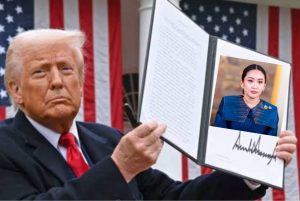
สหรัฐฯ ได้อะไรจากการตั้ง “กำแพงภาษีกับทั้งโลก”?
เป็นกลยุทธ์ที่นำไปสู่ชัยชนะ หรือบั่นทอนตัวเองในระยะยาว?
#อัษฎางค์ยมนาค
หลังทรัมป์ประกาศเก็บภาษี 10% กับสินค้าทุกประเทศทั่วโลก
พร้อมเก็บภาษีโต้กลับ (Reciprocal Tariff) กับประเทศที่สหรัฐฯ ขาดดุลการค้าหนัก
หลายฝ่ายสงสัยว่า… สหรัฐฯ จะได้อะไรจากเกมนี้?
ผลดี (ในเชิงยุทธศาสตร์ระยะสั้น)
1. ลดการพึ่งพาสินค้านำเข้า
ทำให้ภาคการผลิตในประเทศฟื้นตัว เช่น อุตสาหกรรมเหล็ก รถยนต์ พลังงาน อิเล็กทรอนิกส์
2. กระตุ้นเศรษฐกิจในประเทศ
หากประชาชนหันมาซื้อสินค้า Made in USA มากขึ้น จะช่วยกระตุ้นภาคแรงงานและภาคอุตสาหกรรมภายใน
3. ต่อรองเชิงการเมืองกับประเทศคู่ค้า
เป็น “ไม้แข็ง” เพื่อบีบบังคับให้ประเทศอื่นกลับมาเจรจาข้อตกลงที่สหรัฐฯ มองว่า “แฟร์กว่า” เช่น กรณีสหรัฐฯ-จีน หรือสหรัฐฯ-ยุโรป
4. ลดดุลการค้าขาดดุล
โดยเฉพาะกับประเทศที่สหรัฐฯ ขาดดุลมหาศาล เช่น จีน เยอรมนี เม็กซิโก ไทย ฯลฯ
ผลเสีย (ในเชิงโครงสร้างและระยะยาว)
1. ทำให้ต้นทุนสินค้าในประเทศสูงขึ้น
เพราะสินค้าหลายประเภทต้องพึ่งวัตถุดิบหรือชิ้นส่วนจากต่างประเทศ เมื่อถูกเก็บภาษี ต้นทุนจะสูงขึ้น ผู้บริโภคต้องจ่ายแพงขึ้น
2. กระทบผู้ส่งออกสหรัฐฯ เอง
ประเทศคู่ค้าจะตอบโต้ด้วยการเก็บภาษีสินค้าจากสหรัฐฯ เช่น ถั่วเหลือง รถยนต์ ไวน์ ซึ่งส่งผลกระทบต่อเกษตรกรและผู้ผลิตในรัฐที่พึ่งการส่งออก
3. บั่นทอนความน่าเชื่อถือของสหรัฐฯ ในระบบการค้าเสรีโลก
ประเทศอื่นอาจหันไปทำการค้ากันเอง (เช่น RCEP) โดยไม่สนใจระบบนำโดยสหรัฐฯ อีกต่อไป
4. เร่งการเกิด “โลกหลายขั้ว” (Multipolar World)
ประเทศอื่นจะสร้างพันธมิตรทางเศรษฐกิจใหม่ เช่น จีน+รัสเซีย+อาเซียน โดยไม่พึ่งดอลลาร์หรือการค้าเสรีที่อิงกับสหรัฐฯ
5. ผลต่อดัชนีตลาดการเงินและการลงทุน
นักลงทุนจะมองว่าสหรัฐฯ มีความเสี่ยงจากความไม่แน่นอนทางนโยบายการค้า ส่งผลต่อค่าเงิน หุ้น และการไหลออกของเงินทุน
สรุป
• สหรัฐฯ ได้ประโยชน์เชิงการเมืองและภาคแรงงานบางกลุ่มในระยะสั้น
โดยเฉพาะฐานเสียงของทรัมป์ในภาคอุตสาหกรรม
• แต่ในระยะยาว เสี่ยงเสียทั้งพันธมิตรทางเศรษฐกิจ เสียตำแหน่งผู้นำการค้าโลก และเศรษฐกิจภายในประเทศก็อาจถดถอยจากแรงต้านของระบบการค้าโลก
What Does the U.S. Gain from Imposing Tariffs on the Entire World?
A Strategic Victory—or a Long-Term Self-Sabotage?
by Eddie Atsadāng Yommanāk
After Donald Trump announced a sweeping 10% tariff on imports from all countries worldwide, along with reciprocal tariffs targeting nations with which the U.S. runs massive trade deficits, many are asking:
What exactly does the U.S. stand to gain from this move?
Short-Term Strategic Advantages
1. Reducing Dependence on Imports
Domestic industries such as steel, automotive, energy, and electronics may recover as imported goods become less competitive.
2. Stimulating the Domestic Economy
If Americans shift to buying “Made in USA” products, domestic labor and manufacturing sectors could benefit significantly.
3. Political Leverage in Trade Negotiations
Tariffs become a hardline bargaining chip to push countries like China or EU members back to the negotiating table—on terms the U.S. deems “fairer.”
4. Addressing Trade Deficits
The policy directly targets countries with whom the U.S. has major trade imbalances—such as China, Germany, Mexico, and Thailand.
Long-Term Structural Disadvantages
1. Rising Production Costs in the U.S.
Many industries rely on imported raw materials and components. With tariffs in place, production costs rise and so do consumer prices.
2. U.S. Exporters Will Suffer
Retaliatory tariffs from affected countries may target American goods like soybeans, automobiles, and wine—hurting U.S. farmers and exporters, especially in swing states.
3. Undermining U.S. Credibility in Global Trade
Other nations may increasingly turn to regional trade blocs like RCEP instead of relying on U.S.-led free trade frameworks.
4. Accelerating the Rise of a “Multipolar World”
New economic alliances could form—such as China, Russia, and ASEAN—reducing reliance on the U.S. dollar and U.S.-centered trade systems.
5. Impacts on Financial Markets and Investments
Global investors may see the U.S. as politically and economically unstable. This perception can trigger capital flight, currency fluctuations, and stock market volatility.
In Summary
• The U.S. may reap short-term political and industrial gains, particularly among Trump’s blue-collar base.
• But in the long run, the risks include loss of economic alliances, declining global leadership in trade, and potential internal economic backlash driven by global pushback.
It’s a risky game of economic nationalism—one that might yield early applause but long-term consequences.



